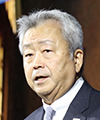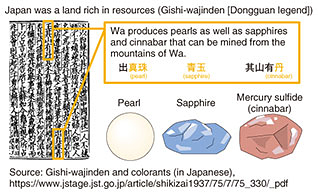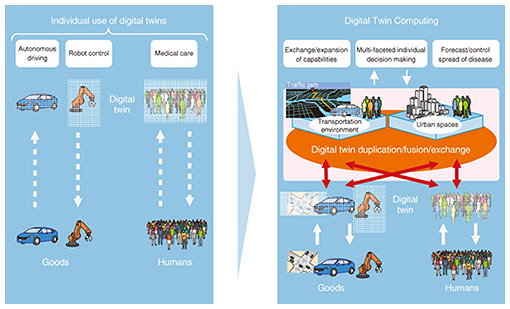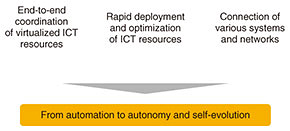 |
|||||||||
|
|
|||||||||
|
Feature Articles: Keynote Lectures at NTT R&D Forum 2019 Vol. 18, No. 2, pp. 10–16, Feb. 2020. https://doi.org/10.53829/ntr202002fa1  Towards the Era of IOWNOverviewThis article presents a lecture given by Jun Sawada, NTT President and Chief Executive Officer, at NTT R&D Forum 2019 held on November 14th and 15th, 2019. The lecture introduced the concept of the Innovative Optical and Wireless Network (IOWN), which was announced by the NTT Group in 2019. Keywords: IOWN, All-Photonics Network, Digital Twin Computing, Cognitive Foundation 1. Characteristics of Japan through historyIn this lecture, I’ll talk about a new information and communication infrastructure called the Innovative Optical and Wireless Network, or IOWN. Before introducing this new concept, I’d like to look back on the history of Japan. Since many international visitors are here today, I’ll explain to you what kind of country Japan is. 1.1 Japan in ancient times (around third century)Japan was introduced in the “Gishi-wajinden”—a first history of Japan, which was written in China during the Three Kingdoms Period (220–280 CE) (Fig. 1). At that time, Japan was called “Wa,” and it was written that “Wa produces pearls as well as sapphires and cinnabar that can be mined from the mountains of Wa.” Sapphire is said to have been abundantly harvested in present-day Toyama and Nara. Cinnabar, also called vermilion, is a compound called mercury sulfide. Although it is very poisonous, it was used as a preservative and in various medicines and paints at the time. Mercury sulfide was mined in Nara in large quantities and Oita and Tokushima. Therefore, we can see from the China’s history book that Japan was a rich resource-producing country.
1.2 Japan during the Edo period (17–19th centuries)In the 17th century, although Japan was mostly a closed society, it actually traded extensively with the Netherlands. For example, in a picture painted by the Dutch painter Vermeer, geographers and astronomers are wearing Japanese-style kimonos, which are said to have been very prized in Europe [1]. Research has shown that 30% of the silver in the world during that time was produced in Japan. The Netherlands imported a considerable amount of silver from Japan through Dejima in Nagasaki. According to Yoshihiko Amino’s book “A History of Japan 00: What is ‘Japan’?” [2], 40% of peasants were engaged in various businesses, such as crafts, as opposed to farming. It seems that crafts produced by these skilled individuals were exported to Europe. Let’s compare Japan with Europe during the Industrial Revolution. The Industrial Revolution was a revolution in energy. For example, in London, labor was being saved, and while capital was being consolidated, energy was being invested in with the aim of spurring economic growth. In contrast, by concentrating labor and saving capital, Edo (present day Tokyo) had become a city with a population of one million with recycling-oriented eco-infrastructures such as a sewerage system. If we compare the two, we can clearly see that the two cities had opposite outlooks. By looking back on history in this way, we can say that Japan was a rich resource-producing country and influenced the world through exports, and Edo was one of the world’s largest eco-metropolises (with a population of one million). 1.3 Structure of modern societyLet’s look at the structure of modern society in terms of economy and the nation (Fig. 2). From an economic point of view, as we have seen in the examples concerning silver and kimonos I mentioned before that free trade existed much earlier than we previously thought. At the national level, the concept of the nation was born after the Peace of Westphalia Treaty in 1648, and after the conflict between socialism and capitalism during the 20th century, divisions between countries due to the rise of protectionism, such as the current US-China trade war, are now expanding. In addition, the flood of information due to big data and information filtering using artificial intelligence (AI) will provide only information that is biased to individual preferences, and this division between individuals will become more apparent.
Next, looking at modern society dualistically, we see contrasting concepts such as “global versus local” and “centralized versus decentralized” (Fig. 3). Telecommunications has transformed from an analog world to a digitized one, which has greatly changed society. It was a process of integrating services and various types of information. However, the recent emergence of edge computing has created a situation in which services and information are integrated and distributed. Although computers have been downsized from mainframes and become widespread, they are also becoming re-centralized through the cloud and decentralized again through edge computing. In other words, we can consider a situation in which centralization and decentralization currently co-exist.
In the past, there were many issues involved in choosing between centralization and decentralization. Today, however, to handle such conflicting concepts, it is necessary to develop a paraconsistent world by connecting both concepts while allowing for such contradictions and to build a society that recognizes diverse values (Fig. 4). Specifically, I believe that sustainable growth can be achieved by reconciling the characteristics of the economic expansion of modern European societies with the recycling society of Edo (Fig. 5).
1.4 From electronics to photonicsExtreme global weather events, such as intense heatwaves in Europe and strong typhoons in Japan, have been occurring more frequently. Experts say that these events are due to global warming. To achieve sustainable growth, I believe that certain technical issues must be overcome. First, the use of the Internet of Things, big data, AI, etc. is progressing rapidly, and power consumption tends to increase with the processing of large amounts of data. What’s more, issues regarding the end of the semiconductor evolution are also being raised. To address these issues, NTT has been researching signal processing using photonics-electronics convergence technologies, which introduces photonics technology into chips, instead of using conventional electronic technology. In April 2019, we announced the development of an optical transistor that operates with the lowest energy consumption in the world [3]. In addition, Intel, Sony, and NTT have announced the establishment of the IOWN Global Forum in the United States as an international initiative to promote photonics-related research and development using photonics-electronics convergence technologies [4]. Photonic devices using photonics-electronics convergence technologies are the basis of IOWN, and we want to use such devices to expand the capabilities of terminals, devices, and applications supported by networks. 2. What is IOWN?IOWN consists of three elements: (i) the All-Photonics Network, which introduces photonics technology from the network to terminals; (ii) Digital Twin Computing, which enables future predictions by integrating the real world with the digital world; and (iii) Cognitive Foundation®, which controls information and communication technology (ICT) resources by connecting everything. 2.1 All-Photonics NetworkIn current networks, it is necessary to convert optical signals into electrical signals at routers for switching paths, etc. In contrast, the All-Photonics Network achieves low power consumption, high quality, large capacity, and low latency by introducing photonics-based technologies for everything from optical fibers to transmission equipment and semiconductors as well as from networks to terminals (Fig. 6). We have begun discussions on wireless technologies for IOWN to increase transmission capacity. We have also announced the beginning of joint research with Japan Aerospace Exploration Agency (JAXA) to expand the use of outer space through, for example, application of satellite MIMO (multiple-input and multiple-output) technology to increase the capacity of communications between low-earth orbit satellites and ground stations. Moreover, we want to develop wireless connection technology for dynamically allocating optimal radio frequencies to users. The creation of the All-Photonics Network will expand the range of optical transmission from end to end, enabling quantum communication by transmitting quantum-entangled states. We want to build a quantum-communication-based platform that will enable quantum cryptography on which eavesdropping cannot occur.
2.2 Digital Twin ComputingDigital twin is a concept that accurately represents real-world objects and people in cyberspace so that predictions and optimal proposals can be made (Fig. 7).
The second element of IOWN, Digital Twin Computing, is an extension of the conventional concept of digital twin. We believe that a new world beyond the real world can be created by multiplying various digital twins. By duplicating, fusing, and exchanging digital twins that even digitize people’s minds such as emotions and values, it will be possible to build a new world in cyberspace and feed back simulation results from that world to the real world. In the meantime, concrete problems concerning what to do to achieve Digital Twin Computing will become apparent. Such problems include configuration and expression of digital twins, interaction with the real world, precise future prediction via digital twins, and construction of a new world view (social-science considerations). I believe that some of these problems will include social-science issues that cannot be dealt with using technological theory alone. Accordingly, we started a collaborative project with a group led by Professor Yasuo Deguchi of Kyoto University. In this project, we will investigate an inclusive parallel world view as a new viewpoint of the real and digital realms based on the philosophy of an Eastern self-view. To put that more concretely, we will consider the world created by digital technology in parallel and inclusively with the real world and study the purpose of life, ethics, and social systems in that digital world. 2.3 Cognitive Foundation®Cognitive Foundation can centrally execute construction, configuration, management, and operation of, for example, the ICT resources of users (Fig. 8). It enables rapid deployment of ICT resources and optimization of configurations of such resources in multi-domain, multi-layer, and multi-service/multi-vendor environments. In the future, it will evolve into fully automated, autonomous, and self-evolving operations.
The current version of Cognitive Foundation has been commercially deployed in Las Vegas, USA. Co-developed with Dell Technologies, it uses the orchestration function from NTT Comware, which implements software by UBiqube (based on the virtualization software of VMware). It allows data to be collected from various systems without being bound by format, and the city can be provided with solutions based on those data to enable reactive responses and proactive predictions. We are planning to expand Cognitive Foundation to other cities. 2.4 A roadmap for IOWNI’ll first describe the roadmaps for each of the three components of IOWN. Regarding the All-Photonics Network, starting with miniaturizing optical transceivers in a few years as devices incorporating photonics-electronics convergence technology, we aim to enable inter-chip optical transmission in the medium term, and in the long term, enable on-chip optical transmission. Also in the medium term, we plan to establish technologies to allocate wavelengths to each service and speed up satellite communications. Regarding Digital Twin Computing, we plan to establish zero-latency media technology for enabling immediate interaction in the short term then build a new world view based on social-science considerations and create digital twins of people (i.e., modeling people’s minds). Finally, from the results of these plans, we aim to develop ultra-high-speed future-prediction technology for driving a virtual society. Regarding Cognitive Foundation, from the level of predictive maintenance in a single system (such as anomaly detection based on deep learning), we are aiming to advance into optimal wireless connection through multi-wireless control technology, autonomous operation of multiple systems, and finally autonomy that uses cooperative autonomous control technology. As 5G (fifth-generation mobile communications) becomes more advanced in parallel with these technological developments, base stations will become software based by working with the Open Radio Access Network (ORAN) in the wireless-access section. In core networks, we believe that white-boxing of hardware will be promoted by the Telecom Infra Project (TIP) and other organizations. The founding members of the IOWN Global Forum, which I mentioned earlier, are Intel, Sony, and NTT, and 65 other companies are currently considering to participate in it, including Orange, Verizon, Microsoft, and Chunghwa Telecom. This forum is expected to receive applications from many organizations in the future, and we want people with knowledge of the humanities and social sciences to join us and study the new world together. 3. Concluding remarksAlthough the NTT R&D Forum introduced exhibitions focused on the keyword IOWN, IOWN is currently evolving and may change periodically into the future. NTT is currently promoting the business model B2B2X (business-to-business-to-X) to create a smart world. The main players are the second “B” in this model (service providers), and NTT’s role is to assist customer transformation as an enabler (namely, a catalyst and supporter). While strengthening our efforts toward a smart world, we hope to simultaneously develop new infrastructure. References
Trademark notesAll brand, product, and company/organization names that appear in this article are trademarks or registered trademarks of their respective owners. |
|||||||||
















